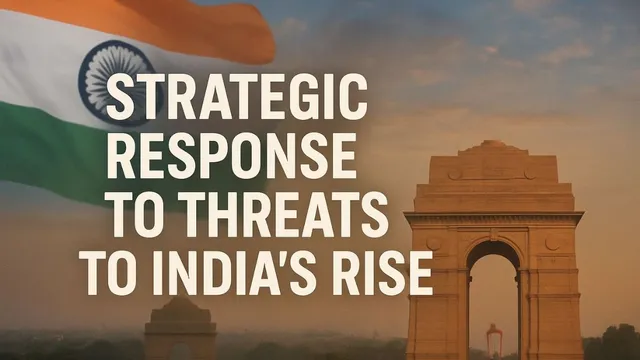- By GN Bajpai
- Fri, 03 Oct 2025 12:50 PM (IST)
- Source:JND
Donald Trump, President of the United States of America (US), called PM Modi to convey greetings on his 75th birthday. A day earlier, the US Chief negotiator arrived in India to restart impeded discussions on the trade agreement. The thaw is welcome.
The US singled out India by imposing the highest rate of 50% tariff on Indian goods effective from August 27, 2025. It was followed by the discontinuance of supplies of essential goods by China. The threat to economic growth was serious. The challenge to hegemony and sometimes sheer envy builds a natural tendency to browbeat and derail the progress of individuals and nations.
India has been subjected to such unfortunate episodic events several times. Fortunately, the political leadership has risen on every such occasion and chosen to remain steadfast, discreet and refused to bend backwards. The pride of India has held on.
The leading powers that have built economic hulk, military prowess, market size and monopoly of critical materials have often used the determinant heft to hold out threats and even punish individuals and nations. Unfortunately, India does not have that Brahmastra to retaliate or respond forcefully. India could not prevent China from actively assisting Pakistan during Operation ‘Sindoor’ and the US vocalising to take unseemly credit for the ceasefire.
PM Modi’s call, "India to be a Developed Nation by 2047", has been and will be threatened over and over again. The time has come to architect a Sudarshan Chakra, which can blow up the onslaught of any threat-geopolitical, economic, and/or energy and retaliate, if need be. Building such a weapon warrants reform, a change in approaches and political will. Benjamin Franklin wrote in 1784, ‘There is no gain without pain”. The short-term pain is worth architecting the balancing prowess.
An earnest and significant beginning has been made with GST reforms on top of Income Tax reduction and simplification. Next should be rationalisation and reduction of import duties, except maybe on agriculture and dairy products. Import duties increase input costs, often needlessly protect industries, build inefficiencies and make the product noncompetitive.
A comprehensive strategy to upgrade manufacturing, agriculture and dairy sectors should be pursued. Deepening of “Make in India” and “Digital India” can support innovation, infrastructure development and skill enhancement. Adaptation of advanced technologies, improving product quality and focusing on value addition will move India’s products up in the value chain and mitigate price pressures.
The two long-standing, extremely pressing and non-negotiable issues are Labour and Judicial Reforms. As per the International Labour Organisation (ILO), India’s labour productivity is relatively low compared to global standards and is estimated to be the lowest amongst the G20 nations. Even with very low wages, our products are not globally competitive.
The World Bank’s ‘Doing Business’ report states that enforcement of a contract in India takes 1445 days on average and costs 25% of the value of the contract. Undertaking these reforms warrants instilling urgency, elimination of rent seeking and architecting consensus amongst all the stakeholders.
Efficacious functioning of liberal markets necessitates a pragmatic regulatory framework. In quite a few cases, the disproportionate emphasis on erecting a level playing field, protection of customers’ interests and maintaining the rhythm of the market has created barriers to innovation and restrictive practices. The committee appointed by the government must quickly recommend approaches to ensure that ease of doing business, innovations and ease of living are furthered.
India’s trade size with the US and China has led to concentration risk. It is essential to spread our trade across geographies. The Government has been pushing bilateral agreements with various governments. The time has come to conclude as many as possible in a quick time.
The Modi government’s regime is credited with maintaining macro-economic stability defined by inflation control, deficit reduction, sovereign debt containment and forex reserves accretion. The global rating agency S&P has upgraded India’s rating after 18 years on the strength of the macroeconomic stability. This must be preserved at all costs.
The hesitation of the Private Sector to invest under the garb of geopolitical risks must be converted to enthusiasm. Since all these measures will take time to fructify, all-out efforts should be made to boost domestic consumption.
Modi’s visit to China and bonhomie with President Xi Jinping and Russian President Putin was a diplomatic master stroke and vivid assertion of India’s swing power. In a battle for supremacy, swing power becomes the trump card. The echoes were felt across the Atlantic. The resumption of trade negotiations by the US and supplies by China is the outcome of that move, of course, assisted by back-channel talks. But this is a temporary relief and not a permanent deterrence.
The ‘Reform, Transform and Perform’ as enunciated by the PM is the only solution for building the ‘Developed Nation’ and forbidding coercion of India by the global powers in the future.
(Disclaimer: The writer is the former Chairman SEBI & LIC, Author & Columnist. Views expressed are personal.

